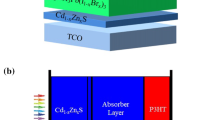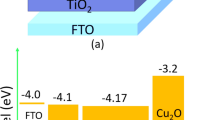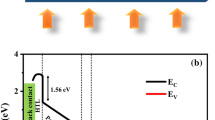Abstract
Currently, organic–inorganic metal halide perovskite material based Photovoltaic cell have achieved an impressive level of success due to their unique properties in the photovoltaic industry. In this paper, primary goal is to examine and compare the characteristics of performance of Pb, Sn and Ge perovskite solar cell structure with additional hole transport and back surface field layer of group IV alloy to achieve the improved efficiency. The simulated device structure consists of electron transport/absorber/hole-transport/back surface field layers where SnO2 material used for electron transport layer (ETL), SiGe and Spiro-OMeTAD materials used for transporting hole layers (HTLs), back-surface field (BSF) layer is of SiGeSn and perovskite absorber layer material are CH3NH3PbI3, CH3NH3SnI3, CH3NH3GeI3, respectively. A comparative analysis is made between three different solar cell structures which is based on Pb, Sn and Ge perovskite material. Higher conversion efficiency is obtained with Pb perovskite solar cell in comparison to Sn and Ge based solar cells. CH3NH3PbI3 exhibits better conversion efficiency as compared to the CH3NH3SnI3 and CH3NH3GeI3 while using the same layer thickness.
Similar content being viewed by others
Data Availability
NA.
References
Demoulin PD, Lundstrom MS (1989) Projections of GaAs Solarcell Performance Limits Based on Two-Dimensional Numerical Simulation. IEEE Trans Electron Devices 36:897–905. https://doi.org/10.1109/16.299671
Zhao P, Yue M, Lei C et al (2018) Device Simulation of organic-inorganic halide perovskite/crystalline silicon four-terminal tandem solar cell with various antireflection materials. IEEE Journal of Photovoltaics 8:1685–1691. https://doi.org/10.1109/JPHOTOV.2018.2869743
Wang Y, Zhong M, Chai L (2018) Effects of the concentration of PbI2 and CH3NH3I on the perovskite films and the performance of perovskite solar cells based on ZnO-TiO2 nanorod arrays. Superlattices Microstruct 123:189–200. https://doi.org/10.1016/j.spmi.2018.07.024
Graetzel M, Malinkiewicz O, Yella A et al (2014) Perovskite solar cells employing organic charge-transport layers. Nat Photonics 8(2):128–132. https://doi.org/10.1038/nphoton.2013.341
Li N, Shi C, Li L et al (2017) Tunable Br-doping CH3 NH3 PbI3-x Brx thin films for efficient planar perovskite solar cells. Superlattice Microst 104:445–450. https://doi.org/10.1016/j.spmi.2017.03.011
Silvaco (2015) ATLAS Device simulation software user’s manual, no. version 3.2, pp 1–124
Alipour H, Ghadimi A (2021) Optimization of lead-free perovskite solar cells in normal-structure with WO3 and water-free PEDOT: PSS composite for hole transport layer by SCAPS-1D simulation. Opt Mater 120:111432. https://doi.org/10.1016/j.optmat.2021.111432
Zhao P, Lin Z, Wang J et al (2019) Numerical Simulation of Planar Heterojunction Perovskite Solar Cells Based on SnO2 Electron Transport Layer. ACS Appl Energy Mater 2:4504–4512. https://doi.org/10.1021/acsaem.9b00755
Bello IT, Awodele MK, Adedokun O et al (2018) Modeling and simulation of CZTS-perovskite sandwiched tandem solar cell. Turk J Phys 42:321–328. https://doi.org/10.3906/fiz-1801-30
Pagliaro M, Ciriminna R, Palmisano G (2008) Flexible solar cells. Chemsuschem 1:880–891. https://doi.org/10.1002/cssc.200800127
Hima A, Lakhdar N, Benhaoua B et al (2019) An optimized perovskite solar cell designs for high conversion efficiency. Superlattices Microstruct 129:240–246. https://doi.org/10.1016/j.spmi.2019.04.007
Sherkar TS, Momblona C, Gil-Escrig L et al (2017) Recombination in Perovskite Solar Cells: Significance of Grain Boundaries, Interface Traps, and Defect Ions. ACS Energy Lett 2:1214–1222. https://doi.org/10.1021/acsenergylett.7b00236
Abdulrazzaq OA, Saini V, Bourdo S et al (2013) Organic solar cells: A review of materials, limitations, and possibilities for improvement. Part Sci Technol 31:427–442. https://doi.org/10.1080/02726351.2013.769470
Kietzke T (2007) Recent advances in organic solar cells. Advances in OptoElectronics 2007:1687–563X. https://doi.org/10.1155/2007/40285
Chang ST, Liao MH, Lin W (2011) Si / SiGe hetero-junction solar cell with optimization design and theoretical analysis. Thin Solid Films 519:5022–5025. https://doi.org/10.1016/j.tsf.2011.01.120
Hussain S, Mehmood H, Khizar M, Turan R (2018) Design and analysis of an ultra-thin crystalline silicon heterostructure solar cell featuring SiGe absorber layer. IET Circuits Devices Syst 12(5):309–314. https://doi.org/10.1049/iet-cds.2017.0132
Lakhdar N, Hima A (2020) Electron transport material effect on performance of perovskite solar cells based on CH3NH3GeI3. Opt Mater 99:109517. https://doi.org/10.1016/j.optmat.2019.109517
Basu R, Kaur J, Sharma AK (2019) Analysis of a Direct-Bandgap GeSn-Based MQW Transistor Laser for Mid-Infrared Applications. J Electron Mater 48:6335–6346. https://doi.org/10.1007/s11664-019-07418-w
Mehmood H, Tauqeer T (2017) Modelling and performance analysis of amorphous silicon solar cell using wide band gap nc-Si: H window layer. IET Circuits Devices Syst 11:666–675. https://doi.org/10.1049/iet-cds.2017.0072
Teng P, An X, Johnson C et al (2015) Modeling of Increased Open Circuit Voltage through Localized Emitter Area on Silicon Solar Cells. Energy Procedia 77:651–657. https://doi.org/10.1016/j.egypro.2015.07.094
Acknowledgements
Jaspinder Kaur is grateful to MHRD government of India, for providing financial support in the form of Post-Doctoral Fellowship. All the authors are grateful to ECE Department of NIT Delhi for providing research facilities to complete this work.
Funding
NA.
Author information
Authors and Affiliations
Contributions
Jaspinder Kaur did the simulations, prepared results and wrote the main manuscript text. Surender Kumar, Rikmantra Basu and Ajay Kumar Sharma reviewed the manuscript.
Corresponding author
Ethics declarations
Ethics Approval
NA.
Consent to Participate
NA.
Consent for Publication
NA.
Competing Interests
The authors declare no competing interests.
Additional information
Publisher's Note
Springer Nature remains neutral with regard to jurisdictional claims in published maps and institutional affiliations.
Rights and permissions
Springer Nature or its licensor (e.g. a society or other partner) holds exclusive rights to this article under a publishing agreement with the author(s) or other rightsholder(s); author self-archiving of the accepted manuscript version of this article is solely governed by the terms of such publishing agreement and applicable law.
About this article
Cite this article
Kaur, J., Kumar, S., Basu, R. et al. Modelling and Simulation of Planar Heterojunction Perovskite Solar Cell featuring CH3NH3PbI3, CH3NH3SnI3, CH3NH3GeI3 Absorber Layers. Silicon 16, 1441–1451 (2024). https://doi.org/10.1007/s12633-023-02761-4
Received:
Accepted:
Published:
Issue Date:
DOI: https://doi.org/10.1007/s12633-023-02761-4




